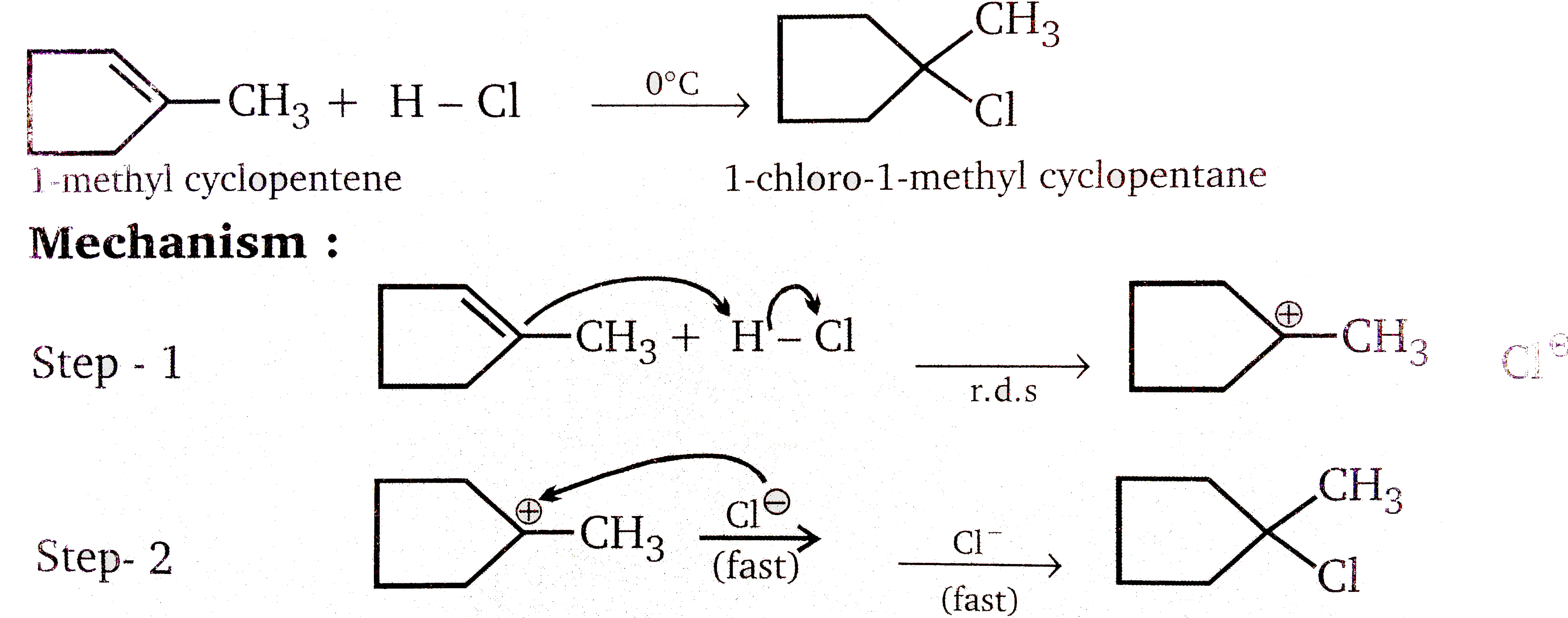Markovnikov addition takes place with unsymmetrical alkenes. The positive part of the reagent gets connected to the double bonded carbon with more number of hydrogens. In presence of peroxide and in special cases addition takes place against Markovnikov rule.
1-methyl cyclohenene on hydroboroation it will giveSolution in Telugu
cis -2-methyl cyclohenanol
trans-2-methyl cyclohenanol
Both a and b
None
The correct Answer is:B
Always forms trans-product
Topper's Solved these Questions
- BOOK - AAKASH SERIESCHAPTER - HYDROCARBONSEXERCISE - ADDITIONAL PRACTICE SHEET ( LEVEL-II (PRACTICE SHEET (ADVANCED) (LINKED COMPREHENSION TYPE QUESTIONS(PASSAGE-II))))3videos
HYDROCARBONS
- BOOK - AAKASH SERIESCHAPTER - HYDROCARBONSEXERCISE - ADDITIONAL PRACTICE SHEET ( LEVEL-II (PRACTICE SHEET (ADVANCED) (LINKED COMPREHENSION TYPE QUESTIONS(PASSAGE-III))))3videos
HYDROCARBONS
- BOOK - AAKASH SERIESCHAPTER - HYDROCARBONSEXERCISE - ADDITIONAL PRACTICE SHEET ( LEVEL-II (PRACTICE SHEET (ADVANCED) (MORE THAN ONE CORRECT ANSWER TYPE QUESTIONS )))24videos
HYDROCARBONS
- BOOK - AAKASH SERIESCHAPTER - GENERAL ORGANIC CHEMISTRYEXERCISE - QUESTIONS FOR DESCRIPTIVE ANSWERS35videos
GENERAL ORGANIC CHEMISTRY
- BOOK - AAKASH SERIESCHAPTER - HYDROGEN AND ITS COMPOUNDSEXERCISE - QUESTIONS FOR DESCRIPTIVE ANSWERS20videos
HYDROGEN AND ITS COMPOUNDS
Similar Questions
Alkenes undergo electrophilic addition with many reagents like HX, H2O, HOCI etc. Except in the case of addition of X−2 in other additions carbocation is formed as intermediate. The rate of such reactions depends on the stability of carbocation. Rearrangements and ring expansion are also common in such reactions.
The correct order of reactivity of the following towards electrophilic addition is
P) Vinyl chloride Q) Pent-2-ene
R) 3-methyl pent-2-ene S) 2,3-dimethyl but-2-ene01:21View SolutionThe ozonolysis reactions used to as certain the position of multiple bonds in a substrate. The most widely used ozonolysis is partial reductive ozonlysis, which is also used for preparation of aldehyde and ketones.

An unsaturate Hydrocarbon (A) C.Hreadily gives (B) on treatment with NaNH, with 1-chloropane, C is obtained on partial hydrogenation with Lindaar's catalyst C gives D. On ozonolysis, (D) gives 2,2-dimethyl propanal and 1-butanal.
A is05:06View SolutionWhich of the following are the best method(s) for the preparation of cumene (A) ?
View SolutionMention the hybridisation stste of each carbon in the following compounds.
CH3−CH=C=O,CH3−C≡C−CH3,CH3COCH3andCH2=CHCNView SolutionWhy the use of hard water is disadvantages?
02:41View SolutionWhich of the following hydrogen halides in the presence of peroxides undergoes addition reaction with propene in an anti-Markovnikov fashion?
03:59View SolutionVladimir Markovnikov rule:
Alkenes undergo electrophilic addition reactions. It is triggered by the acid acting as a electrophile toward π-electrons of the double bond.
Markovnikov's rule states that when an unsymmetrically substituted alkene reacts with a hydrogen halide, the hydrogen atom adds to the carbon that has the greater number of hydrogen, e.g.,
 Which of the following is most reactive toward Markovnikov addition?05:41View Solution
Which of the following is most reactive toward Markovnikov addition?05:41View SolutionIn the presence of peroxide, hydrogen chloride and hydrogen iodide do not give anti-Markovnikov addition to alkenes because :
04:20View SolutionThe addition of HI in the presence of peroxide does not show anti-Markovnikov behavior because
03:00View SolutionThe addition of HBr to an unsymmetrical alkene takes place in accordance with …….. Rule.
02:29View SolutionThe alkenes have π-bonds which make them highly reactive. These undergo electrophilic addition reactions, Addition of HX to unsymmetrical alkenes gives two products and follow Markovnikov rule and anti- Markovnikov rule. The addition occure through the formation of carbocation in Markovnikov rule and free radicals in anti-Markovnikov zule. The ozonolysis reaction of alkenes helps to locate the position of double bond.
Predict the major product in the following reaction:
CH3−CH=CH2HBr−−−−−−→(PhCOO)202:45View SolutionThe alkenes have pi -bonds which make them highly reactive. These undergo electrophilic addition reactions, Addition of HX to unsymmetrical alkenes gives two products and follow Markovnikov rule and anti- Markovnikov rule. The addition occure through the formation of carbocation in Markovnikov rule and free radicals in anti-Markovnikov zule. The ozonolysis reaction of alkenes helps to locate the position of double bond. Write the major product in the following reaction: CH_(3)- overset(CH_(3))overset(|)CH-CH=CH_(2) overset(HBr)to
02:08View SolutionThe alkenes have pi -bonds which make them highly reactive. These undergo electrophilic addition reactions, Addition of HX to unsymmetrical alkenes gives two products and follow Markovnikov rule and anti- Markovnikov rule. The addition occure through the formation of carbocation in Markovnikov rule and free radicals in anti-Markovnikov zule. The ozonolysis reaction of alkenes helps to locate the position of double bond. What product is obtained when propene reacts with CI_(2) in the presence of water?
02:58View SolutionThe alkenes have pi -bonds which make them highly reactive. These undergo electrophilic addition reactions, Addition of HX to unsymmetrical alkenes gives two products and follow Markovnikov rule and anti- Markovnikov rule. The addition occure through the formation of carbocation in Markovnikov rule and free radicals in anti-Markovnikov zule. The ozonolysis reaction of alkenes helps to locate the position of double bond. Name the products formed when 2-methylpropene is treated with ozone followed by Zn, H_(2)O .
02:54View SolutionThe alkenes have π-bonds which make them highly reactive. These undergo electrophilic addition reactions, Addition of HX to unsymmetrical alkenes gives two products and follow Markovnikov rule and anti- Markovnikov rule. The addition occure through the formation of carbocation in Markovnikov rule and free radicals in anti-Markovnikov zule. The ozonolysis reaction of alkenes helps to locate the position of double bond.
Ozonolysis of an alkene 'A' followed by decomposition with water and a reducing agent gave a mixture of two isomers of the formula C3H6O. Give the structure of the alkene and its IUPAC name.04:40View Solution

